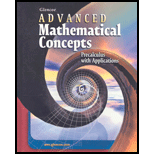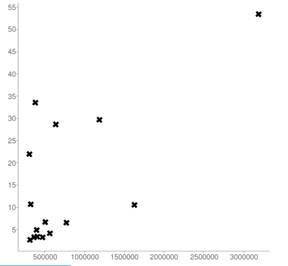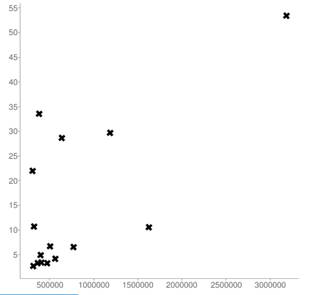
Concept explainers
a.
To graph: the data on the
a.
Answer to Problem 31E

Explanation of Solution
Given information:
The table of values given is as follows:
| Workers 16 years and older | Percent of workers using public transportation |
| 3183088 | 53.4 |
| 1629096 | 10.5 |
| 1181677 | 29.7 |
| 772957 | 6.5 |
| 640577 | 28.7 |
| 560913 | 4.2 |
| 500566 | 6.7 |
| 473966 | 3.3 |
| 400932 | 3.5 |
| 395551 | 4.9 |
| 382309 | 33.5 |
| 362777 | 3.3 |
| 325054 | 10.7 |
| 312958 | 2.7 |
| 307679 | 22.0 |
Calculation:
The graph for the given data is shown below.

b.
To find: best fit line using two ordered pairs.
b.
Answer to Problem 31E
Explanation of Solution
Given information:
The table of values given is as follows:
| Workers 16 years and older | Percent of workers using public transportation |
| 3183088 | 53.4 |
| 1629096 | 10.5 |
| 1181677 | 29.7 |
| 772957 | 6.5 |
| 640577 | 28.7 |
| 560913 | 4.2 |
| 500566 | 6.7 |
| 473966 | 3.3 |
| 400932 | 3.5 |
| 395551 | 4.9 |
| 382309 | 33.5 |
| 362777 | 3.3 |
| 325054 | 10.7 |
| 312958 | 2.7 |
| 307679 | 22.0 |
Calculation:
Let’s select any two ordered pair like
Now, plug the value of m and any one point coordinate into the slope intercept equation and evaluate b as follows:
Now, plug the values of m and b in the slope intercept formula as follows:
Thus, the line equation is
c.
To find: the equation for
c.
Answer to Problem 31E
Explanation of Solution
Given information:
The table of values given is as follows:
| Workers 16 years and older | Percent of workers using public transportation |
| 3183088 | 53.4 |
| 1629096 | 10.5 |
| 1181677 | 29.7 |
| 772957 | 6.5 |
| 640577 | 28.7 |
| 560913 | 4.2 |
| 500566 | 6.7 |
| 473966 | 3.3 |
| 400932 | 3.5 |
| 395551 | 4.9 |
| 382309 | 33.5 |
| 362777 | 3.3 |
| 325054 | 10.7 |
| 312958 | 2.7 |
| 307679 | 22.0 |
Calculation:
The graph for the above equation is as follows:

Using the graphing calculator, the regression line equation is as follows:
Using the graphing calculator, the
d.
To find: the percentage of worker using public transports in Baltimore, Maryland and explain whether the prediction is reliable.
d.
Answer to Problem 31E
Prediction is not reliable.
Explanation of Solution
Given information:
The table of values given is as follows:
| Workers 16 years and older | Percent of workers using public transportation |
| 3183088 | 53.4 |
| 1629096 | 10.5 |
| 1181677 | 29.7 |
| 772957 | 6.5 |
| 640577 | 28.7 |
| 560913 | 4.2 |
| 500566 | 6.7 |
| 473966 | 3.3 |
| 400932 | 3.5 |
| 395551 | 4.9 |
| 382309 | 33.5 |
| 362777 | 3.3 |
| 325054 | 10.7 |
| 312958 | 2.7 |
| 307679 | 22.0 |
Calculation:
The equation of regression line shows strong relationship because
Plugging
Since the actual value of Baltimore is listed as 22.0, the prediction from the equation for the regression line is not very reliable.
Chapter 1 Solutions
Advanced Mathematical Concepts: Precalculus with Applications, Student Edition
Additional Math Textbook Solutions
University Calculus: Early Transcendentals (3rd Edition)
Single Variable Calculus: Early Transcendentals (2nd Edition) - Standalone book
Calculus: Early Transcendentals (3rd Edition)
Calculus: Early Transcendentals (2nd Edition)
Precalculus (10th Edition)
Calculus and Its Applications (11th Edition)
 Calculus: Early TranscendentalsCalculusISBN:9781285741550Author:James StewartPublisher:Cengage Learning
Calculus: Early TranscendentalsCalculusISBN:9781285741550Author:James StewartPublisher:Cengage Learning Thomas' Calculus (14th Edition)CalculusISBN:9780134438986Author:Joel R. Hass, Christopher E. Heil, Maurice D. WeirPublisher:PEARSON
Thomas' Calculus (14th Edition)CalculusISBN:9780134438986Author:Joel R. Hass, Christopher E. Heil, Maurice D. WeirPublisher:PEARSON Calculus: Early Transcendentals (3rd Edition)CalculusISBN:9780134763644Author:William L. Briggs, Lyle Cochran, Bernard Gillett, Eric SchulzPublisher:PEARSON
Calculus: Early Transcendentals (3rd Edition)CalculusISBN:9780134763644Author:William L. Briggs, Lyle Cochran, Bernard Gillett, Eric SchulzPublisher:PEARSON Calculus: Early TranscendentalsCalculusISBN:9781319050740Author:Jon Rogawski, Colin Adams, Robert FranzosaPublisher:W. H. Freeman
Calculus: Early TranscendentalsCalculusISBN:9781319050740Author:Jon Rogawski, Colin Adams, Robert FranzosaPublisher:W. H. Freeman
 Calculus: Early Transcendental FunctionsCalculusISBN:9781337552516Author:Ron Larson, Bruce H. EdwardsPublisher:Cengage Learning
Calculus: Early Transcendental FunctionsCalculusISBN:9781337552516Author:Ron Larson, Bruce H. EdwardsPublisher:Cengage Learning





